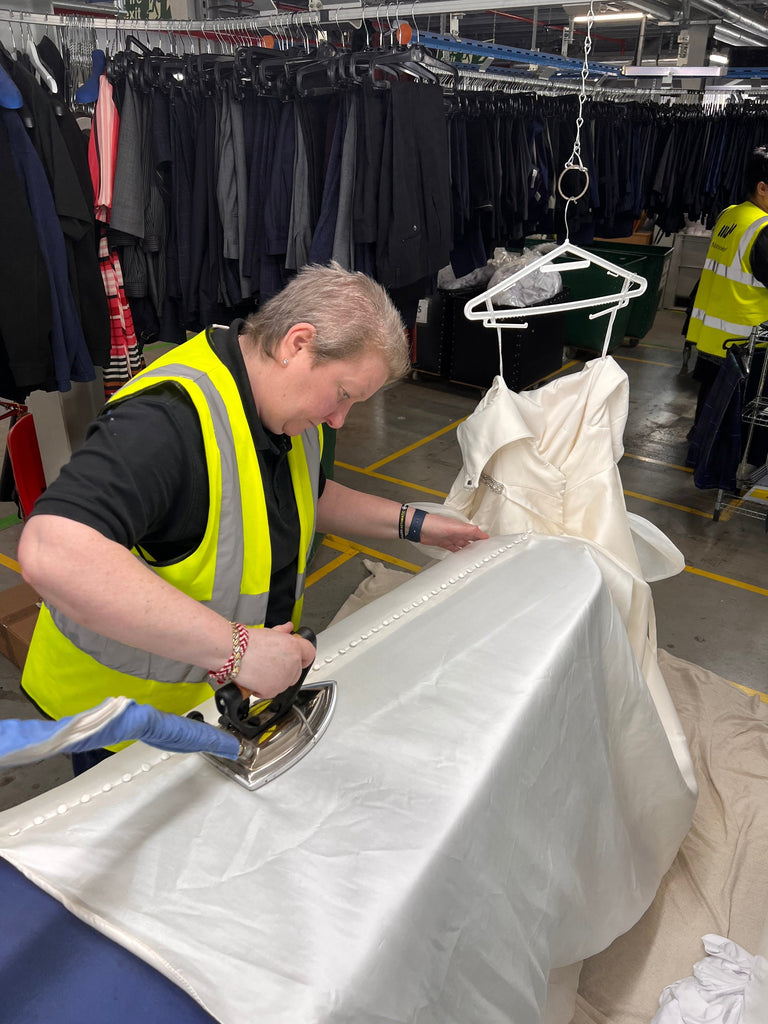Your wedding dress is one of the most cherished garments you'll ever own—a symbol of your big day and an investment that deserves the utmost care and attention. Proper wedding dress cleaning and wedding dress preservation are crucial to ensuring it remains in pristine condition for years to come. At Dorothy Dress Cleaning, we specialise in professional dress cleaning and dry cleaning services to keep your gown looking flawless. In this guide, we’ll cover the do’s and don’ts of wedding dress cleaning, common fabric types, and how to store your dress properly after cleaning.
Types of Fabrics We Clean and How to Care for Them
Wedding dresses come in a variety of delicate fabrics, each requiring specialised care. Below are the most common materials and their cleaning requirements:
1. Crepe
Characteristics: Crepe has a slightly textured finish due to high-twist yarns.
Drawbacks: It may shrink after dry cleaning, so professional care is essential.
Tip: Avoid excessive moisture during cleaning to maintain its crisp texture.
2. Satin
Characteristics: A glossy, smooth fabric that can be made from silk, polyester, or acetate.
Drawbacks: Satin can snag easily, and colours may fade over time.
Tip: Professional dress cleaning is recommended to maintain its sheen and prevent damage.
3. Silk
Characteristics: A luxurious, strong, and soft fabric with a natural sheen.
Drawbacks: Expensive and sensitive to water stains.
Tip: Always opt for wedding dress dry cleaning to avoid damage.
4. Tulle
Characteristics: A fine, stiff net fabric used for veils and overlays.
Drawbacks: Prone to snags and pulls from heavy embroidery.
Tip: Dry cleaning is the safest option to protect delicate tulle layers.
5. Velvet
Characteristics: A plush, luxurious fabric with a soft pile.
Drawbacks: Easily flattened by moisture and stains.
Tip: Avoid water exposure and rely on professional dry cleaning for optimal care.
6. Lace
Characteristics: A delicate, intricate fabric with openwork designs.
Drawbacks: Prone to snagging and unraveling.
Tip: Gentle wedding dress cleaning is required to maintain lace’s detailed patterns.
7. Organza
Characteristics: A sheer, stiff fabric often used for veils and skirts.
Drawbacks: Easily damaged by moisture due to poor water absorption.
Tip: Store and clean organza dresses with professional care to maintain their shape.
8. Mikado
Characteristics: A silk and nylon blend with a crisp texture.
Drawbacks: Heavy fabric, making stain removal challenging.
Tip: Opt for wedding dress dry cleaning to prevent crinkling and shrinkage.
9. Polyester
Characteristics: A synthetic, cost-effective, and easy-to-clean fabric.
Drawbacks: Can stain and discolour easily.
Tip: Professional dress cleaning ensures long-term preservation and prevents discolouration.
How to Store Your Wedding Dress After Cleaning
Proper wedding dress preservation is as important as cleaning. Follow these essential storage tips to protect your gown:
Do’s for Storing Your Wedding Dress
✔ Store in a Cool, Dark Place: Avoid sunlight, heat, and humidity to prevent fading and fabric deterioration.
✔ Use an Acid-Free Storage Box: Protect your gown from dust, light, and accidental damage with a breathable, acid-free box.
✔ Use Acid-Free Tissue Paper: Prevent creasing by cushioning folds with acid-free tissue paper.
✔ Store in a Breathable Garment Bag: White, breathable fabric bags allow airflow while shielding the dress from dust and dirt.
✔ Hang the Dress Properly: If hanging, use loops instead of straps to avoid fabric stretching.
✔ Inspect Regularly: Check your dress every six months for discolouration or damage.
Don’ts for Storing Your Wedding Dress
✖ Avoid Plastic Covers for Long-Term Storage: Plastic traps moisture, leading to mildew and yellowing. Use only for short-term transport.
✖ Do Not Store in Regular Cardboard Boxes: Standard boxes may cause fabric discolouration.
✖ Never Wrap in Coloured Tissue Paper: Dyes from coloured paper can transfer onto the dress. Use only acid-free white tissue paper.
✖ Avoid Long-Term Hanging: Hanging the dress indefinitely may stretch and distort the fabric. Instead, lay it flat in a storage box.
✖ Do Not Store in the Attic or Basement: Extreme temperatures and humidity can damage the fabric and invite pests.
Conclusion: Preserve the Beauty of Your Wedding Dress for Years
Your wedding dress holds priceless memories, and with the right wedding dress cleaning and wedding dress preservation, it can remain as stunning as the day you wore it. At Dorothy Dress Cleaning, we specialise in professional dress cleaning and dry cleaning to help you maintain your gown’s elegance. Contact us today for expert care and preservation services!
Write something...


Leave a comment